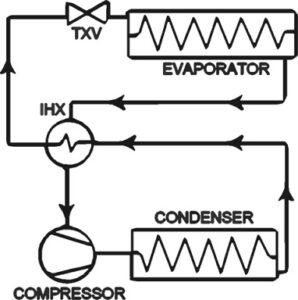The subcooling is a valuable process in the refrigeration and HVAC system
It can be obtained by knowing the temperature of the circulating refrigerant and the saturation temperature at the corresponding pressure.
It can be defined as a refrigerant existing at a temperature less than the refrigerant’s boiling point.
It is a valuable process to ensure that the refrigerant passes through the thermal expansion device.
Subcooling formula
The subcooling of a liquid, particularly in the context of refrigeration cycles, is calculated by the formula:
![]()
(Subcooling value = Temperature of saturated liquid – Temperature of liquid line)
Where:
 is the temperature of the saturated liquid at a given pressure, measured in degrees Fahrenheit (°F) or Celsius (°C).
is the temperature of the saturated liquid at a given pressure, measured in degrees Fahrenheit (°F) or Celsius (°C). is the temperature of the liquid line or the actual temperature of the refrigerant liquid as it exits the condenser, also in °F or °C.
is the temperature of the liquid line or the actual temperature of the refrigerant liquid as it exits the condenser, also in °F or °C.
How to Calculate Subcooling
To calculate subcooling in a refrigeration system:
Record the Liquid Temperature:
Using a surface temperature probe, measure the temperature of the liquid refrigerant as it leaves the condenser. This is your liquid line temperature.
Determine the Saturated Liquid Temperature:
Do this by converting the high side pressure at the condenser’s exit into its corresponding saturated liquid temperature. A pressure/temperature chart or comparator specific to your refrigerant type will be required here, as different refrigerants have different pressure-temperature relationships. The resulting saturated temperature is your saturation temperature.
Calculate Subcooling:
Apply this formula:
![]()
Practical Example
Assume that you measure 115°F for the liquid leaving temp ![]() . Using a pressure/temperature chart, you find that your high side pressure corresponds to a saturated liquid temp
. Using a pressure/temperature chart, you find that your high side pressure corresponds to a saturated liquid temp ![]() of 125°F.
of 125°F.
If you plug those values into the formula, you get:
![]()
So, in this case there is a 10°F subcooling which means that heat is being efficiently removed from your refrigerant by your condenser and fully condensed into its liquid form before it reaches the expansion valve.
How to measure subcooling in HVAC ?
The subcooling can be measured by following the simple steps
- Obtain steady-state condition for measurement
- Keep the system run till you get sure about the steady-state condition
- Attach the thermocouple between the condenser and the expansion valve to measure the temperature of the refrigerant line
- Note the temperature of the refrigerant line
- Measure the pressure at the condenser with the pressure measuring instrument (pressure gauge)
- Find the condenser saturation temperature with the pressure reading with the chart.
- Find the difference between the condenser saturation temperature and the refrigerant line temperature.
- The difference between both temperature is the subcooling
The system’s temperature can be measured with various temperature measuring instruments like RTD, Thermocouple and digital thermocouple, etc. The bourdon tube pressure gauge is attached to the system to obtain the pressure. The pressure-temperature chart converts the pressure data into corresponding saturation temperature. The process of subcooling measurement is simple, but accuracy in reading is required to obtain the correct value.
The value of subcooling is helpful to find the many problems situated in the system. If the subcooling value is not proper, then there are chances of the following problems in the system,
- Insufficient airflow over the condenser tubes
- Expansion problem associated with an expansion device
- There is no sufficient refrigerant in the system
- Troubleshooting
How to calculate subcooling in refrigeration?
The subcooling in the refrigeration can be calculated with the values of temperatures.
It is a difference of two temperatures; one is the temperature of saturated liquid and the temperature of the liquid line.
The subcooling can be calculated with the following equation after measurement of the values with the experiment.

Subcooling value = Temperature of saturated liquid – Temperature of liquid line
The subcooling can be measured in a refrigerator with the following steps:
- Measure the pressure at the receiver. Measure with the pressure gauge
- Use the pressure-temperature chart to obtain the value of the saturation temperature of the refrigerant
- Measure the real temperature of the refrigerant circulating through the condenser. Measure the value at the outlet of the condenser
- Take the difference between both temperatures. The value of the difference is the value of the subcooling.
- The value of the subcooling is helpful to find various issues associated with the refrigeration system.
How to calculate target subcooling ?
Target Subcooling is obtained using the target subcooling chart
It can obtain by finding the indoor wet bulb temperature and the outdoor dry bulb temperature.
The meaning of indoor wet-bulb temperature is the measurement of indoor temperature with a thermometer bulb covered with a wet cloth.
The outdoor dry bulb temperature can be measured by placing the thermometer outside the environment. Care should be taken to avoid putting a thermometer in direct sunlight.
The outdoor dry bulb is the outdoor ambient temperature of the air entering the compressor coils. Thermometer placement is essential, keep out of the sun.
Different manufacturer of HVAC system follows different method to calculate target subcooling. They follow their own target subcooling chart to find the target subcooling.
The manufacturer provides the value of target subcooling with the system.
The target subcooling is provided on the rating plate of the system. It is named “TXV Subccoling” on the rating plate. This number of target subcooling is not very high; it is slightly as per the manufacturer.
How to calculate subcooling 410a ?
The equation calculates the subcooling of the refrigerant 410a
Subcooling value of refrigerant R – 410a = Temperature of saturated refrigerant R – 410a – Temperature of liquid line
The calculation method and formula remain the same for every refrigerant. The temperature values are changed according to the nature of the refrigerant.
The refrigerant R410a is a member of the family hydrofluorocarbon.
How to calculate subcooling r22 ?
The equation calculates the subcooling of the refrigerant R22
Subcooling of refrigerant R22 = Temperature of saturated refrigerant R22 – Temperature of liquid line
The measurement of both temperatures can be done by a few steps discussed in the topic above. You can visit the above topic for more detail on practical how-to measure temperature and pressure for calculation.
The chemical name of the R22 is mono chlorofluoromethane
How to calculate subcooling r134a ?
The equation calculates the subcooling of the refrigerant R134a
Subcooling value of refrigerant R134a = Temperature of saturated refrigerant R134a – Temperature of liquid line
The chemical name of the R134a is 1, 1, 1, 2 – Tetraflouroethane.

I am Deepak Kumar Jani, Pursuing PhD in Mechanical- Renewable energy. I have five years of teaching and two-year research experience. My subject area of interest are thermal engineering, automobile engineering, Mechanical measurement, Engineering Drawing, Fluid mechanics etc. I have filed a patent on “Hybridization of green energy for power production”. I have published 17 research papers and two books.
I am glad to be part of Lambdageeks and would like to present some of my expertise in a simplistic way with the readers.
Apart from academics and research, I like wandering in nature, capturing nature and creating awareness about nature among people.
Also refer my You-tube Channel regarding “Invitation from Nature”